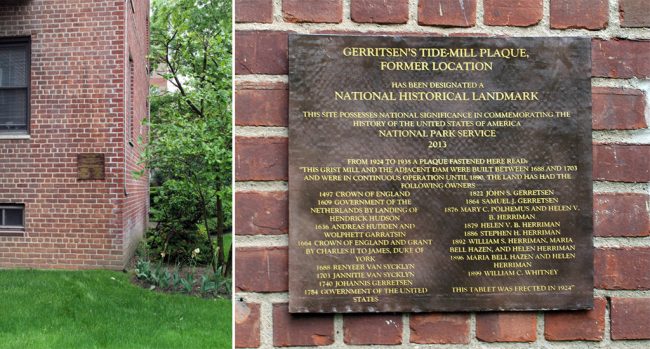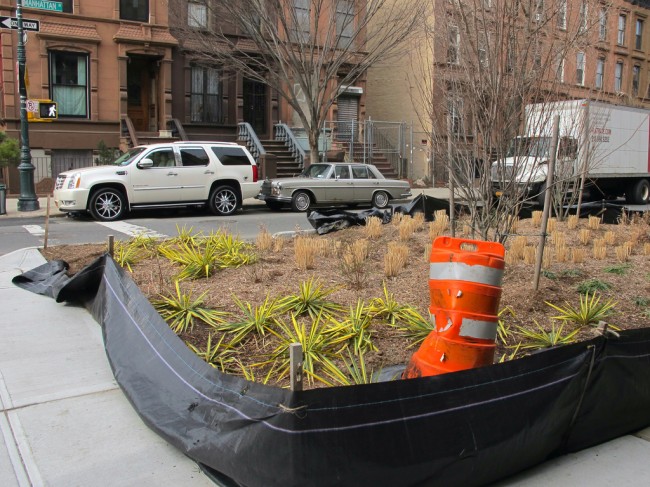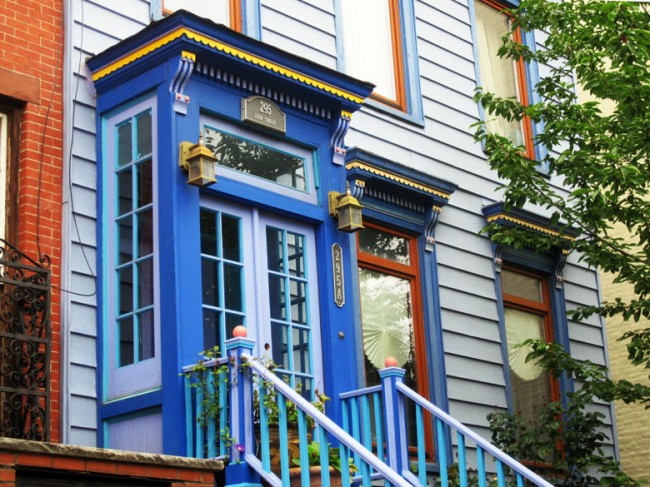
We are celebrating 15 years — and counting — of stories that are deeply researched and deeply felt, that build a historical record of what the city has been.
We are celebrating 15 years — and counting — of stories that are deeply researched and deeply felt, that build a historical record of what the city has been.
First up, a reminder: it’s not too late to buy your tickets to our annual benefit, an evening of drinks, Dinosaur BBQ, and a silent auction at the Malt House at 461 West 126 Street, next Thursday, June 13th. Preview some of the auction items here (and above), including the work of many artists, designers, and architects you have seen on Urban Omnibus. Tickets start at just $50!

A plaque commemorating the former use of the site of a current apartment building | Photo courtesy of Anna Robinson-Sweet
STOLEN BASES AND ROLLER DISCO
Take a walk around Brooklyn, and you may stumble upon some new plaques noting locations of some — false — “National Historic Landmarks.” Last week, artist Anna Robinson-Sweet unleashed a guerilla installation project titled, National Register of Historic Places, 2013 Additions, Brooklyn, NY. To “question how historical memory is recorded through our built environment,” she selected ten sites at random across Brooklyn and through research uncovered something of historical value that once took place at each location. Robinson-Sweet then fabricated plaques to demarcate these places and explain their historical relevance, which include the place where the sliding stolen base was “invented,” the former site of the Gettysburg Cyclorama, and the birthplace of Roller Disco. A map of the plaque locations can be found on the artist’s website.
NO LONGER BURNING
Earlier this year, we spoke with WHEDco founder and president Nancy Biberman about, among other things, the obstacles to overcoming widespread negative perception of a place one call’s home. This week, The New York Times looks at the Bronx’s uphill battle to move beyond its characterization as “a national symbol of urban decay.” In a related photo essay, Times photographer Ángel Franco revisits locations highlighted as particularly dangerous or bleak in news coverage from the 1960s and ’70s to compare the South Bronx then and now.
THAMES BRIDGE
The Tribeca Trib looks at the newly revealed renderings of the West Thames Street Pedestrian Bridge, designed by WXY Architecture and Weidlinger Associates. The new design features a glass roof, a double-lenticular truss painted “George Washington Bridge grey,” and additional stair and elevator access. The article claims that at peak times a remarkable 1,100 pedestrians per hour are expected to cross the bridge, which connects Battery Park City to the Financial District over West Street. If the designs are approved by the Public Design Commission, construction will begin in November.

Bioswale under construction at 122nd Street & Manhattan Avenue in Manhattan | Photo by Kristine Paulus
BIOSWALES
On Monday, the City unveiled 19 new bioswales near Newtown Creek. These curbside gardens collect diverted rainwater from streets before it enters the sewer system, mixes with raw sewage, and flows untreated into area waterways. 20 feet long and five feet wide, each bioswale can collect 2,244 gallons of water during a storm. By 2015, the City plans to install 5,500 bioswales in Brooklyn, the Bronx, and Queens as part of a broad push to build more green infrastructure.
POST SANDY REFLECTION
In a recent Places essay, Tom Vanderbilt reflects on post-Sandy New York. Navigating through the damages still left behind by the storm — closed storefronts up Old Fulton Street, rust-colored waterlines in South Ferry Station — he brings attention to the looming question of how New York should move forward. Given the difficulty of changing an existing built environment, Vanderbilt argues for the need to be strategic in making these changes and puts all options on the table: elevating buildings, moving residents from flood zones, and installing hard and soft storm infrastructure.

A wood house in South Slope, Brooklyn | Photo via The Wooden House Project
EVENTS AND STUFF TO DO
WOODEN HOUSE WALKING TOUR
Wood-frame row houses have been banned in most parts of New York for over a century due to fire risk, making those that do exist a special piece of the city’s fabric. On Sunday, urban historian Elizabeth Finkelstein will lead the first of a series of wooden house walking tours in Brooklyn’s South Slope. To purchase tickets and learn more about the project, check out Finkelstein’s blog, The Wooden House Project.
SHIFTING LIVES: PHOTOGRAPHING THE IMMIGRANT EXPERIENCE IN CHINATOWN
This Saturday, head to UnionDocs Center for Documentary Art for an event highlighting the immigrant experience in Chinatown, including Annie Ling’s photographs of 81 Bowery, a tenement building inhabited by Chinese immigrant laborers, and filmmaker Lynne Sachs’s hybrid documentary, Your Day is My Night. Both projects revolve around themes of memory, place, and loss. The event starts at 7:30pm, with a suggested donation of $9.
LE CORBUSIER
This weekend, AIA New York is hosting Le Corbusier/New York, an international symposium that explores the influential architect’s ideas before and after his first visit to the United States, and examines his legacy. While the tour portions of the event are already sold out, tickets are still available for the Saturday lectures. The symposium is held in conjunction with the upcoming MoMA exhibition, Le Corbusier: An Atlas of Modern Landscapes, which showcases the French modernist’s artistic explorations of observed and imagined landscapes, and opens June 15th.
The Roundup keeps you up to date with topics we’ve featured and other things we think are worth knowing about.
The views expressed here are those of the authors only and do not reflect the position of The Architectural League of New York.